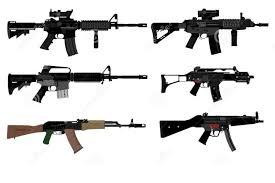The Evolution of Automatic Firepower
Automatic weapons have come a long way since their origins in the late 19th century. Some of the earliest automatic firearms included the Maxim gun, developed in 1883, which could fire hundreds of rounds per minute and helped facilitate more mobile, mechanized infantry tactics on the battlefields of World War I. The 1920s and 1930s saw further innovations as countries worked to develop weapons for potential future conflicts. Germany's MP18, one of the earliest submachine guns, provided stormtroopers with a compact automatic firearm, while the M1918 Browning Automatic Rifle gave U.S. soldiers a light machine gun option.
By World War II, most major military powers had fielded a range of fully automatic weapons for various roles on the modern battlefield. The Germans deployed the Sturmgewehr 44, considered the first assault rifle, which balanced firepower and mobility. The Americans and British employed light machine guns like the Browning M1919 and Vickers for squad support. Submachine guns like the American Thompson and German MP40 offered automatic fire at close ranges. Larger caliber general-purpose machine guns like the MG34 and MG42 also provided sustained suppressive fire. This proliferation of weapons helped enable new mobile warfare tactics but also contributed to unprecedented casualty levels.
The Effects of Automation in Modern Conflicts
Since WWII, they have become even more deadly as military technology has advanced. Assault rifles firing intermediate cartridges became standardized in armies worldwide in the 1960s-1980s after the formative AK-47 and M16 designs. Weapon mounts and chain-driven feeding mechanisms boosted rates of fire. New materials made automatic arms lighter yet more durable. Electronic fire control now allows crew-served weapons to pour out suppressive or destructive fire with greater accuracy and volume. Thermal optics help machine gun teams operate day or night.
These advances have aggravated the brutality of modern battles. Automatic weapons saturate zones with projectiles, making forward movement potentially lethal. Their ability to sweep wide areas means enemies have less space to maneuver or find cover. Sustained automatic fire can also psychologically stress troops by creating an almost constant perception of threat. High casualty influxes challenge the capacity of battlefield medical evacuation systems. Urban combat becomes an even deadlier closed-quarter melee when opposing forces are both heavily armed with assault rifles, submachine guns and light machine guns.
Controls, Regulation and Proliferation Concerns
While there are certainly military uses for automatic weapons, there are also reasonable concerns about inappropriate proliferation. Since the end of the Cold War, the global arms market has become flooded with millions of ex-military firearms. Many end up fuelling protracted insurgencies or falling into militant hands in fragile regions. There is evidence terrorist organizations sometimes obtain lighter automatic arms through foreign proxy networks or corrupt officials. They may employ assault rifles and machine pistols to maximized casualties in mass casualty attacks rather than remaining restricted to improvised explosives.
A number of countries and international agreements aim to curb excessive or irresponsible proliferation of automatic arms. Key diplomatic initiatives include the UN Protocol against the Illicit Manufacturing of and Trafficking in Firearms and their Ammunition, and the Firearms Protocol. States also maintain strategic export controls on fully-automatic weapons per agreements like the Wassenaar Arrangement. Some national legislations outright ban civilian ownership of military-style automatic firearms, while others impose strict monitoring, purchasing restrictions and regulations on private collectors. Although laws and diplomacy have helped address uncontrolled flows to an extent, diversions still fuel serious threats in several conflict-stricken regions.
Deadly Technology Driving Modern Battle Tactics
It is evident that automatic weapons continue playing an integral, if controversially lethal, role on the battlefields of the 21st century based on recent conflicts. Assault rifles remain the backbone of most infantry units worldwide - whether wielded by regular armies, militias, insurgents or terrorists. The AK-47 in particular is one of history's most abundant firearms with perhaps 100 million produced. Advanced militaries also field new-generation select-fire arms optimised for both full-auto suppression as well as accurate semi-auto fire.
On the squad and fireteam level, liberal use of assault rifles enables flexible maneuver and close fire support between small units. Automatic bursts pin down enemies to allow teammates to move to firing positions or flank the opposing force. Lighter general-purpose machine guns often mounted on armored vehicles can provide sustained automatic cover from a protected posture. Such firepower underpins modern mobile warfare - from fighting terrorists in built-up zones to mechanized maneuvers on larger battlefields. With proper tactics and leadership, it allows small forces to achieve overmatch against numerically superior irregular enemies.
However, this firepower comes at the cost of escalated lethality and risks of being turned against civilian populations. Automation arms future conflicts with sobering dilemmas - from how to balance capabilities in an era of urban war to mitigating unintended harms and proliferation externalities that imperil stability in fragile regions. Addressing concerns over the human toll and societal disruption wrought by increasingly deadly technologies will remain an issue for policymakers and military strategists alike for the foreseeable future.
About Author:
Ravina Pandya, Content Writer, has a strong foothold in the market research industry. She specializes in writing well-researched articles from different industries, including food and beverages, information and technology, healthcare, chemical and materials, etc. (https://www.linkedin.com/in/ravina-pandya-1a3984191)
*Note:
1. Source: Coherent Market Insights, Public sources, Desk research
2. We have leveraged AI tools to mine information and compile it

